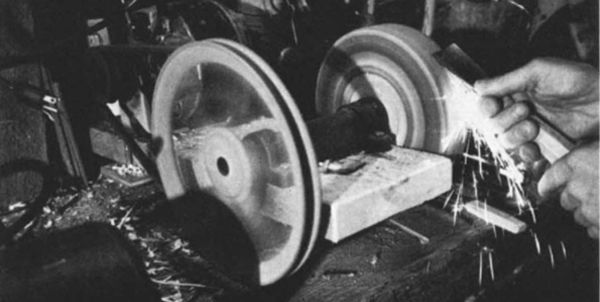
Synopsis: Mark White teaches woodworking, and here he explains how he designed a sharpening system that turns slower than 300 rpm. This way, he reduces the risk of friction-caused heat drawing the temper of his tools. The horizontal wheel allows flat grinding rather than hollow, and he says you can use a conventional grindstone or a flat wooden plate covered with an abrasive disc. He uses a crowned wooden disc covered with leather and charged with an abrasive compound for stropping. In this succinct article, he explains how he built the system and how to use it.
To reduce the risk of friction-caused heat drawing the temper of my tools, I designed a simple-to-make sharpening system that incorporates a vertical shaft turning slower than 300 RPM. The horizontal wheel, which allows flat grinding rather than hollow, may be a conventional grindstone or a flat wooden plate covered with an abrasive disc. For stropping, I use a crowned wooden disc covered with leather and charged with an abrasive compound.
The heart of the system, shown below left, is a laminated disc bolted to a standard pipe flange, which is in turn screwed to a short length of 1 1/4-in. pipe. The pipe turns in two bearings made of 4-in. by 4-in. by 9-in. chunks of hickory. I bored the holes for the bearings with an adjustable bit set to bore about 1/16-in. larger than the pipe’s diameter, to compensate for swelling of the block and tightening of the hole when oiled. If you drill oversize and experience wobble in the shaft, you can cant the blocks until they bear upon the shaft. The hole in the upper block should pass entirely through it. The lower block should be drilled 1 in. short of going through, so that the shaft has a full inch of wood to rest on as it turns.
To make the pulley, I bandsawed two 14-in. discs and one 12-in. disc from 5/8-in. plywood. I marked and drilled the centers of these discs to take a 3/8-in. bolt and used these center holes to position the discs during glue-up, sandwiching the smaller disc between the two larger ones.
Next I lag-bolted the bearing blocks to the front edge of my workbench, lubricated them with chainsaw oil and inserted the pipe with pipe flange. I positioned the laminated pulley on top of the flange, and marked, drilled and bolted it in place.
The vertical-shaft motor I took from a junked washing machine. I mounted the motor on the workbench, hooked it up to the pulley and let it run for about 30 minutes in order to wear in the hickory bearings. The face of the flange did not run perpendicular to the axis of rotation, but a bit of fiddling with a couple of cardboard shims between the pulley and the flange leveled the disc.
From Fine Woodworking #30
For the full article, download the PDF below:
Fine Woodworking Recommended Products

Wen Diamond Grinding Wheel

Incra Miter 1000HD






















Log in or create an account to post a comment.
Sign up Log in